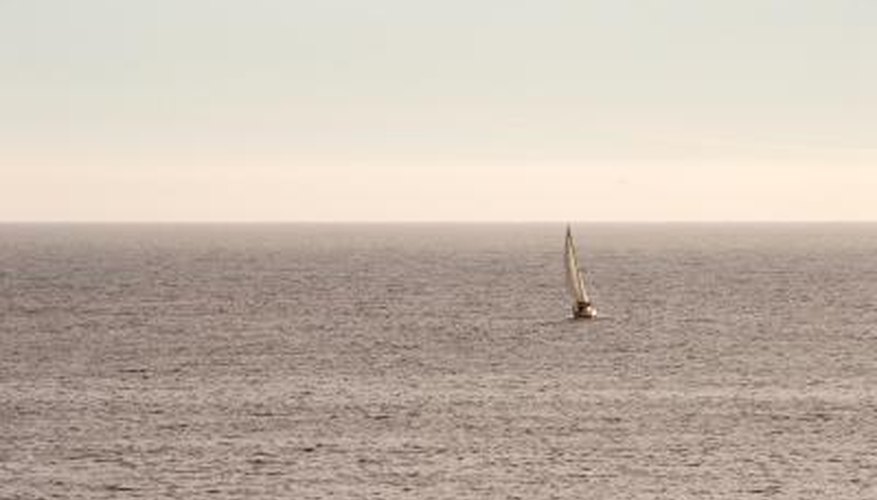
A boat that is converted to sail power will never sail as well as a boat that was designed to sail, but sails can still add a little extra power to a human-powered vessel or provide a low-cost and green alternative to a motor. In order to convert a boat to sail power you will need to solve four problems: selecting a hull, keeping the boat from sliding sideways, mounting the sails, and steering the boat. Perform all calculations before you make any modifications to your boat.
Items you will need
Hull
Sails
Masts
Plywood
Lumber
Epoxy
Fiberglass cloth
Pintles and gudgeons
Rope
Selecting a Hull
Step 1
Evaluate your hull shape. Many of your decisions will be affected by the boat that you are trying to convert. In general, boats designed for sailing are efficient displacement hulls, although some light sailboats are able to rise up on plane given the right conditions. Dedicated sailboats are usually fairly wide with fine entries — they come to a very sharp point at the water line. In addition, dedicated sailboats will have deep keels or some other way of helping the boat resist the pressure of the wind. Most human-powered boats are very narrow with fine entries and exits, like the shape of canoes and kayaks. Row boats usually have the same fine shape at the water line, although they may have more flare and width above the water. Displacement-hull power boats also have smooth shapes. Planing hulls, like the hulls of most small powerboats, are very wide in the stern in order to ride the water pressure and rise up on plane. In the bow, a planing hull will rise up most efficiently if it is wide and shallow, like a Carolina skiff or jon boat, while it will take waves and chop most readily if both the bow of the boat and the front of the hull are sharply v-shaped. In other words, both the bow and stern of a planing powerboat are designed to be effective at high power and high speed, and are very inefficient at sailing speed.
Step 2
Use your hull shape to determine how large your sail should be. A canoe, kayak, or rowing boat converted to sail will be unstable, but will not need a lot of power. A planing powerboat in displacement mode will be sluggish and require larger masts and bigger sails to go as fast as displacement hulls of the same length. A displacement-hull powerboat will perform best, so look for one of these if you are acquiring a boat to convert.
Step 3
Calculate the amount of square footage you will need in your sails by using your boat width and its sailing characteristics. Using conservative sail-area ratios, your sail area, in square feet, should be between 1/6 and 1/4 of your boat's weight in pounds. Remember to include the weight of cargo and crew in this calculation. So a 60-pound rowing boat with 200 pounds of captain and cargo would need 260/6 or about 42 square feet of sail — a surprisingly small sail. A 1,500 pound powerboat with 500 pounds of captain, crew, and gear would require up to 500 square feet of sail. When in doubt, use the smaller sail.
Step 4
Plan for how you will recover your boat when — not if — it capsizes. You will want to be able to right the boat and bail it out or have it bail itself out. If you can't do this, then the boat is not self-rescuing and should not be used in rough water or without a chase boat. Small boats, such as canoes and rowing boats, can be righted with only the captain's weight. Large boats, such as converted powerboats, may not be able to right themselves when they go over.
Keeping the Boat from Sliding Sideways
Step 1
Determine what you will use to keep the boat from moving sideways. When the sails press on the boat it will move both away from the wind and perpendicular to the face of the sail. This is fine if the wind is behind the boat, but if it is to the side or on a forward angle, then the boat will get pushed downwind. In order to keep the boat going forward, not sideways, you will need some way to resist this pressure. Deep displacement sailboats, like the tall ships, simply had deep hulls shaped to resist the water sideways while slipping through the water fore and aft. Modern sailboats use a thin flat extension from the hull to serve this function. It can either be a fixed keel attached to the boat, a centerboard that swings up and down in a box mounted inside the boat, a daggerboard that slides up and down in a box mounted inside the boat, or a leeboard mounted on the side of the hull. Of these, the easiest to add to a conversion hull is a leeboard.
Step 2
Identify where to mount your board. If you are using a leeboard, it must go at the widest point in the hull. If the hull has a long straight section, as in a jon boat, then it can go anywhere near the middle of the boat. A centerboard or daggerboard can be mounted in a variety of places. Measure your boat and divide it into quarters. Place most or all of the centerboard or daggerboard in the second quarter of the hull, just forward of the mid-line.
Step 3
Size your board. It should be about 6% the area of your sails. The board can be made out of plywood, with steel weights at the bottom to help sink it, and covered with fiberglass and epoxy. The board should be foil-shaped or fairly thin. Round the front or leading edge of the board and taper the rear.
Step 4
Mount your daggerboard or centerboard by cutting a hole in the hull for the board, then building a box inside the hull to hold the board and keep the water out. If possible, bring the top of the box up to the height of the gunwales so as to minimize the chance of water slopping into the hull when it is swamped after a capsize. The box can be built out of anything watertight. Building a frame of sticks with sides of plywood, and attaching the whole in a bed of epoxy, is a good solid construction method. The board does not have to be located in the center of the boat, and having an off-center board makes only a trivial difference in boat performance.
Step 5
Mount your leeboard by attaching it on a pivot or in a slide on the outer hull of the boat. Make sure that the board can be raised and lowered from the captain's position. You can run ropes through pulleys to the front and back of the board, which will allow you pull the board both forward and backward and thus move it up or down. Pivoting leeboards can be moved forward and aft to adjust sailing performance, and are superior if your hull allows you to mount the board that way.
Mounting the Masts
Step 1
Decide how many sails you will use. Single sails are more efficient but harder to place, and put more tipping force on the boat. Multiple sails can be used to balance the boat, but require more masts and more strings to pull. For most conversions a two-sail rig such as a cat ketch is easy and convenient.
Step 2
Measure your sails and identify the center point of each sail. The sails will push sideways on the boat with a force proportional to the sail area and concentrated at the middle of the sail. In order for the boat to balance, that force needs to land near the center of lateral resistance. For most boats this will be right about at the location of the board.
Step 3
Use the size and force of each sail to determine where its mast should be located. A cat ketch rig gives you the opportunity to mount the main mast in a location where it can be well supported. You can then fine-tune the location of the lighter mizzen mast to ensure that the boat will balance.
Step 4
Build a mast step for each mast. This must include a strong point on the hull to keep the force of the mast from driving the mast down through the boat. It must also include strong lateral resistance. For smaller boats, the old standby of a step mounted to the hull and a thwart with a hole in it is a good solution. For a larger boat, build a sturdy tabernacle for the mast. The masts do not have to be located on the center line, and can easily be built into the side of the boat, but if you use two masts try to put one on each side.
Step 5
Test the rigging by attaching the standing rigging to the masts, mounting the masts on the boat, attaching the sails, and raising them. Make sure that you can perform all of these tasks easily when you launch or use your boat. Take the masts down and adjust any fittings until all works well.
Final Details
Step 1
Check the layout of the boat and build or adjust seats in the proper location for sailing. In general, you will want to sit in the back of the boat on the windward side, and be able to change sides quickly. Use this seating location when determining what sort of tiller or other steering apparatus to use.
Step 2
Calculate your required rudder size by taking about 2% of the sail area. If you are converting a displacement boat you may be able to simply enlarge the existing rudder, but you will probably want to use special brackets and pins to attach a rudder to the back of the boat. These brackets — called gudgeons — and pins — or pintles — can be purchased at any marine-supply shop.
Step 3
As with the centerboard, make the rudder out of plywood or thin wood, and coat it with a layer of fiberglass. Round the front or leading edge and taper the back or trailing edge.
Step 4
Attach a tiller to the rudder and make sure that it will reach to the captain's seat. The actual design of the tiller will depend on the size and shape of your boat, but a basic piece can be made by smoothing a 1-by-2-inch piece of wood with a plane so that it fits in your hand. If you will need to sit forward in the boat for balance, consider using a push-pull tiller, steering ropes, or even foot pedals to control the rudder.
Step 5
Varnish all your woodwork. You can keep the ropes from getting tangled by making eyes — small blocks of wood with holes drilled through them — and running all the rigging through these eyes. Add cleats to tie off loose lines. Ensure that your boat has sufficient flotation and that all passengers and crew are wearing life jackets at all times. Go sailing!
References
- Ted Brewer Explains Sailboat Design, Ted Brewer, 1985
- The Nature of Boats, Dave Gerr, 1992
- Boatbuilding for Beginners, Jim Michalak, 2002
Writer Bio
Edward Kilsdonk has been a freelance writer since 2010. He created, produced and wrote online high school classes for Apex Learning in U.S. history, U.S. geography and politics, and U.S. government. Kilsdonk earned a Master of Arts in economic history from the University of Virginia and a Bachelor of Arts in history from Amherst College.



